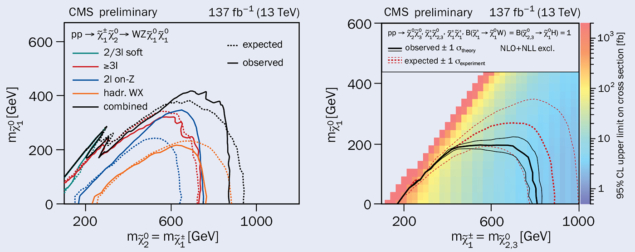A report from the CMS experiment.

The CMS collaboration has been relentlessly searching for physics beyond the Standard Model (SM) since the start of the LHC. One of the most appealing new theories is supersymmetry or SUSY – a novel fermion-boson symmetry that gives rise to new particles, “naturally” leads to a Higgs boson almost as light as the W and Z bosons, and provides candidate particles for dark matter (DM).
By the end of LHC Run 2, in 2018, CMS had accumulated a high-quality data sample of proton–proton (pp) collisions at an energy of 13 TeV, corresponding to an integrated luminosity of 137 fb–1. With such a large data set, it was possible to search for the production of strongly interacting SUSY particles, i.e. the partners of gluons (gluinos) and quarks (squarks), as well as for SUSY partners of the W and Z bosons (electroweakinos: winos and binos), of the Higgs boson (higgsinos), and of the leptons (sleptons). The cross sections for the direct production of SUSY electroweak particles are several orders of magnitude lower than those for gluino and squark pair production. However, if the partners of gluons and quarks are heavier than a few TeV, it could be that the SUSY electroweak sector is the only one accessible at the LHC. In the minimal SUSY extension of the SM, electroweakinos and higgsinos mix to form six mass eigenstates: two charged (charginos) and four neutral (neutralinos). The lightest neutralino is often considered to be the lightest SUSY particle (LSP) and a DM candidate.
CMS has recently reported results, based on the full Run 2 dataset, from searches for the electroweak production of sleptons, charginos and neutralinos. Decays of these particles to the LSP are expected to produce leptons, or Z, W and Higgs bosons. The Z and W bosons subsequently decay to leptons or quarks, while the Higgs boson primarily decays to b quarks. All final states have been explored with complementary channels to enhance the sensitivity to a wide range of electroweak SUSY mass hypotheses. These cover very compressed mass spectra, where the mass difference between the LSP and its parent particles is small (leading to low-momentum particles in the final state) as well as uncompressed scenarios that would instead produce highly boosted Z, W and Higgs bosons. None of the searches showed event counts that significantly deviate from the SM predictions.
CMS maximised the output of the Run 2 dataset, providing its legacy reference on electroweak SUSY searches
The next step was to statistically combine the results of mutually exclusive search channels to set the strongest possible constraints with the Run 2 dataset and interpret the results of searches in different final states under unique SUSY-model hypotheses. For the first time, fully leptonic, semi-leptonic and fully hadronic final states from six different CMS searches were combined to explore models that differ depending on whether the next-to-lightest supersymmetric partner (NLSP) is “wino-like” or “higgsino-like”, as shown in the left and right panels of figure 1, respectively. The former are now excluded up to NLSP masses of 875 GeV, extending the constraints obtained from individual searches by up to 100 GeV, while the latter are excluded up to NLSP masses of 810 GeV.
With this effort, CMS maximised the output of the Run 2 dataset, providing its legacy reference on electroweak SUSY searches. While the same data are still being used to search for new physics in yet uncovered corners of the accessible phase-space, CMS is planning to extend its reach in the upcoming years, profiting from the extension of the data set collected during LHC Run 3 at an unprecedented centre-of-mass energy of 13.6 TeV.
Further reading
CMS Collab. 2023 CMS-PAS-SUS-21-008.








